A "screw" is just the mechanism that drives the dies together. Screw turns but dies don't.
That statement is absolutely true for US Mint coins 1792-1836 struck on screw presses. The dies were set in die sockets with a set screw, which was the interface between the screw and the hammer die. The sockets would wear out before the screw end. With that setup, the working dies had no torsional force. The coin die erosion from that period is always radial.
Elias Boudinot dated 11-2-1795, describing the Chief Coiners's Orders, "He is also to take care that there be constantly kept, spare rollers, dies, milling stamps, sockets, &c. that no delay be suffered by their breaking."
However, if the die setup at another mint had looser tolerances and no interface between the screw and the hammer die, there would be torsional force on the dies (Bombay Mint 120 years ago?).
What is the die alignment on these coins? Are they rotated?
Robert Scot: Engraving Liberty - biography of US Mint's first chief engraver
Downward pressure will cause metal flow outward and cause radial flow lines. From the center outward
Turning pressure would reduce the amount of required downward force.
Turning pressure would also cause turning flow of the devices/design elements.
Turning pressure could also cause ghosting as the fields would distort next to the design elements.
A loose die would have to be loose for the life of the die, if it were tightened it would change the flow.
A screw press is designed to apply downward pressure not a turning pressure.
If the lines are flow lines from a screw press they should be fairly consistent across all years.
Maybe @messydesk can show us some slight variations showing different directions.
Flow lines are not as consistent and even as the lines shown.
The coin shows classic signs of directional buffing of the die.
The orange arrows show the direction the buffing tool moved or rotating direction.
The red circles show no lines and still have sharp corners. The buffing tool was coming off this edge and was not able to damage it. Like coming off the edge of a cliff
The yellow lines show where the buffing tool came back in contact and buffed off the corner of the design element. Like crashing into the cliff on the other side
Let us assume two different styles of screw presses. Style A has the anvil die firmly set in a holder. No rotation. The hammer die is firmly set in a holder that moves up and down. No rotation. Radial flow lines only.
Style B has the anvil die firmly set in a holder. No rotation. The hammer die is firmly attached to the end of the rotating screw. Plenty of rotation.
What direction would the flow lines run? I would guess radial on the anvil side and spiral on the hammer side.
Don’t these BTD’s show the spiral die erosion on both sides?
Numismatist. 54 year member ANA. Former ANA Senior Authenticator. Winner of four ANA Heath Literary Awards; three Wayte and Olga Raymond Literary Awards; Numismatist of the Year Award 2009, and Lifetime Achievement Award 2020. Author "The Enigmatic Lincoln Cents of 1922," due out late 2025.
I think what I believed to be an innocent and instructional post will turn out to be an eye-opener. As I wrote before, I was told that old screw presses were used to strike coins at the Bombay (now Mumbai) Mint in India including Trade dollars. I also wrote that when I tried to provide a link to this information, I only found two indications that this was a fact. I can prove the screw presses were sent there; however, nothing I could find w/o paying money to download two books containing the Numismatic History of India or Minting Practices in India indicated that: "British Trade dollars made in India were struck using a screw press!" I called a very informed, LIVING numismatist who I was positive would know (the ones who taught me this are dead) but he did not.
So, I am still convinced my "answer" is correct BUT in the interest of not spreading false info, let's continue this discussion. I'll bet the answer will be forthcoming as I thought this was something "every knowledgeable numismatist" already knew and I was shocked that the answer was not given by the second or third post!
Additionally, from now on, consider me ignorant on this subject and treat anything I write as just another OPINION in case I forget to add that!
Die polish does not look like this! The depth and thickness of the RAISED grooves would indicate that someone was trying to DESTROY the dies with a rotary tool rather than polish them. IMO, this effect is from die wear imparted by the torque of the (possible old and loose) press .
@messydesk said: "I'm now wondering if this is an exercise in not trusting everything you see in print."
This was not a trick question. I posted something that I thought was common knowledge, imparted by knowledgeable numismatist consultants of the time and backed up by the obvious evidence (curved worn die radials) on the coins themselves. This effect is also seen on other coins from British India.
@ifthevamzarockin wrote that he "respectfully disagrees" that the British Trade dollars struck in Inda were not made using old steam-operated screw presses.
Whoa there buckaroo, I don't see where I said "British Trade dollars struck in Inda were not made using old steam-operated screw presses."
"@ifthevamzarockin wrote that he "respectfully disagrees" that the British Trade dollars struck in Inda were not made using old steam-operated screw presses."
"I'm waiting for your evidence."
This is what I quoted and thought we were talking about.
"These coins were struck on old screw presses. The image shows curved flow lines due to erosion of the die as more and more coins were struck in the same way that "radials" occur."
Respectfully disagree..... I will post after we kill a few more cats.
Right here you are agreeing that you see the use of a rotary tool.
I'm not sure how you can confirm their intent if you were not there watching and talking to them.
First you were saying these are flow lines now you are saying they are lines from a rotary tool and someone trying to destroy the die..... I guess I am confused.
If they were trying to destroy the die wouldn't they use a grinder rather than a buffing wheel? "someone was trying to DESTROY the dies with a rotary tool rather than polish them."
@ifthevamzarockin said:
Whoa there buckaroo, I don't see where I said "British Trade dollars struck in Inda were not made using old steam-operated screw presses."
"@ifthevamzarockin wrote that he "respectfully disagrees" that the British Trade dollars struck in Inda were not made using old steam-operated screw presses."
"I'm waiting for your evidence."
This is what I quoted and thought we were talking about.
"These coins were struck on old screw presses. The image shows curved flow lines due to erosion of the die as more and more coins were struck in the same way that "radials" occur."
Respectfully disagree..... I will post after we kill a few more cats.
Right here you are agreeing that you see the use of a rotary tool.
I'm not sure how you can confirm their intent if you were not there watching and talking to them.
First you were saying these are flow lines now you are saying they are lines from a rotary tool and someone trying to destroy the die..... I guess I am confused.
If they were trying to destroy the die wouldn't they use a grinder rather than a buffing wheel? "someone was trying to DESTROY the dies with a rotary tool rather than polish them."
WHAT I AM POINTING OUT is I SAID IT and you made a very bold statement in a very respectable way :
Respectfully disagree.....
Where I come from that indicates I posted rubbish that you disagreed with! I hoped you were going to educate all of us.
SIMPLE ENGLISH: I don't agree with ANYTHING posted by anyone in this thread that attempted to answer the cause of these lines EXCEPT what I posted as an answer! The coin in the image was struck using a screw press at the Bombay Mint.
I am not a "know-it-all." Note that when you respectfully disagreed I replied, "excellent" because I expected to learn the TRUTH if what I was taught was incorrect.
ALSO NOTE that I tried to indicate that ANY of the posted opinions (rotary die polish) MAY ACTUALLY BE THE TRUTH based on facts that you indicated by your disagreement might be forthcoming SOON. I don't wish to change what may turn out to be a very informative and educational discussion into a HE SAID, HE SAID circle romp!
If you respectfully disagree with my statement that British Trade dollars struck at the Bombay Mint were made using old steam screw presses sent from London (FACT: at least one Boulton & Watts screw press was STILL used at the Royal Mint in London until 1881) let's get on with it.
Hopefully, this discussion will be moved to the foreign forum on Monday.
A "screw" is just the mechanism that drives the dies together. Screw turns but dies don't.
That statement is absolutely true for US Mint coins 1792-1836 struck on screw presses. The dies were set in die sockets with a set screw, which was the interface between the screw and the hammer die. The sockets would would wear out before the screw end. With that setup, the working dies had no torsional force. The coin die erosion from that period is always radial.
Elias Boudinot dated 11-2-1795, describing the Chief Coiners's Orders, "He is also to take care that there be constantly kept, spare rollers, dies, milling stamps, sockets, &c. that no delay be suffered by their breaking."
However, if the die setup at another mint had looser tolerances and no interface between the screw and the hammer die, there would be torsional force on the dies (Bombay Mint 120 years ago?).
What is the die alignment on these coins? Are they rotated?
Coin turn. Don't recall rotation and I don't have an example on hand except for some counterfeits.
@CaptHenway said:
Let us assume two different styles of screw presses. Style A has the anvil die firmly set in a holder. No rotation. The hammer die is firmly set in a holder that moves up and down. No rotation. Radial flow lines only.
Style B has the anvil die firmly set in a holder. No rotation. The hammer die is firmly attached to the end of the rotating screw. Plenty of rotation.
What direction would the flow lines run? I would guess radial on the anvil side and spiral on the hammer side.
Don’t these BTD’s show the spiral die erosion on both sides?
Great observation!
Yes, erosion on both sides, but going from memory they may be different in intensity. Assuming the top, downward-coming die, twisted in one direction when it came into contact with the planchet, wouldn't the planchet RESTING on the bottom die twist in the same direction only a little less. Or, would the rotation on the face of the coin's reverse be in the opposite direction? Without the coin to look at...
@ifthevamzarockin said:
This was about lines not location of the mint.
LOL, the location of the Mint is the reason the coin looks this way. If I remember correctly, The British Trade dollars struck in London have normal radials.
BTW, please keep the discussion about coins and not about "feet" or personalities. Factual research and mutual respect between numismatists works better than loosely-veiled, attempted "put-downs."
@CaptHenway said:
Let us assume two different styles of screw presses. Style A has the anvil die firmly set in a holder. No rotation. The hammer die is firmly set in a holder that moves up and down. No rotation. Radial flow lines only.
Style B has the anvil die firmly set in a holder. No rotation. The hammer die is firmly attached to the end of the rotating screw. Plenty of rotation.
What direction would the flow lines run? I would guess radial on the anvil side and spiral on the hammer side.
Don’t these BTD’s show the spiral die erosion on both sides?
Great observation!
Yes, erosion on both sides, but going from memory they may be different in intensity. Assuming the top, downward-coming die, twisted in one direction when it came into contact with the planchet, wouldn't the planchet RESTING on the bottom die twist in the same direction only a little less. Or, would the rotation on the face of the coin's reverse be in the opposite direction? Without the coin to look at...
Good question as to would a turning hammer die cause the planchet to turn during the strike until it was sufficiently anchored into the incusations in the anvil die. I do not know.
If it did, I would expect the flow lines on the reverse to be shorter and weaker.
Numismatist. 54 year member ANA. Former ANA Senior Authenticator. Winner of four ANA Heath Literary Awards; three Wayte and Olga Raymond Literary Awards; Numismatist of the Year Award 2009, and Lifetime Achievement Award 2020. Author "The Enigmatic Lincoln Cents of 1922," due out late 2025.
I posted showing evidence of directional buffing or polishing, sorry you do not see it.
"SIMPLE ENGLISH: I don't agree with ANYTHING posted by anyone in this thread that attempted to answer the cause of these lines EXCEPT what I posted as an answer! The coin in the image was struck using a screw press at the Bombay Mint."
If you are the only one that can have a correct answer there is little need for anyone to reply.
Sorry you are closed off to open communication.
If you respectfully disagree with my statement that British Trade dollars struck at the Bombay Mint were made using old steam screw presses sent from London (FACT: at least one Boulton & Watts screw press was STILL used at the Royal Mint in London until 1881) let's get on with it.
Your thread was about the lines on the coin not the location of the mint that stuck the coin.
I enjoy your posts and have no desire for any conflict or hard feelings. I am sorry if I offended you in any way.
I have never said you are a "know it all" or that you post "rubbish" and would not do so.
I don't see where I mentioned "feet" and why you are injecting words in my communications.
Because you are the only one that can be right I will just have to agree with you that I am wrong.
I am more than happy to stand down on this discussion.
@ifthevamzarockin said:
Now you change the title to your thread??????
Yes! Made good sense to me. Due to the fact that I respected your disagreement and awaited forthcoming details from you in case my information was incorrect as you posted, I felt my discussion was no longer "ANSWERED."
Now, the only important thing to discuss is what kind of press was used to strike BTD in India. I wish to know if I have been misinformed all these decades.
Die polish does not look like this! The depth and thickness of the RAISED grooves would indicate that someone was trying to DESTROY the dies with a rotary tool rather than polish them. IMO, this effect is from die wear imparted by the torque of the (possible old and loose) press .
@messydesk said: "I'm now wondering if this is an exercise in not trusting everything you see in print."
Maybe U.S. Mint die polish does not look like this. Do we know that British India die polish doesn't look like this? I really don't know, hence I ask. How did they polish their dies?
We could just as easily respond to your supposition that it is flow lines from a screw press by saying "flow lines don't look like this". But your response is/was that the screw press flow lines look like that.
I'm not saying I KNOW anything here. I was just trying to ascertain how we could tell those lines weren't die polish. Maybe they polished their dies by running them against a rotary buffer.
All comments reflect the opinion of the author, even when irrefutably accurate.
@CaptHenway said:
Let us assume two different styles of screw presses. Style A has the anvil die firmly set in a holder. No rotation. The hammer die is firmly set in a holder that moves up and down. No rotation. Radial flow lines only.
Style B has the anvil die firmly set in a holder. No rotation. The hammer die is firmly attached to the end of the rotating screw. Plenty of rotation.
What direction would the flow lines run? I would guess radial on the anvil side and spiral on the hammer side.
Don’t these BTD’s show the spiral die erosion on both sides?
Great observation!
Yes, erosion on both sides, but going from memory they may be different in intensity. Assuming the top, downward-coming die, twisted in one direction when it came into contact with the planchet, wouldn't the planchet RESTING on the bottom die twist in the same direction only a little less. Or, would the rotation on the face of the coin's reverse be in the opposite direction? Without the coin to look at...
Good question as to would a turning hammer die cause the planchet to turn during the strike until it was sufficiently anchored into the incusations in the anvil die. I do not know.
If it did, I would expect the flow lines on the reverse to be shorter and weaker.
EXACTLY! and wouldn't the curvature go in the same direction looking down at each side.
BTW, the reason I took the image I posted in the first place (long ago) is because this coin had extremely pronounced curvature "flow" - more indication of just simple die wear from a screw press than normally seen on these coins.
There are two mints in play, here. Coins were also made in Calcutta in 1900-1902. I will look at those as well. Some later issues were made in London, but I don't currently have those.
This is what I quoted and thought we were talking about.
"These coins were struck on old screw presses. The image shows curved flow lines due to erosion of the die as more and more coins were struck in the same way that "radials" occur."
Respectfully disagree..... I will post after we kill a few more cats.
>
I don't think @ifthevamzarockin was disagreeing about the screw press. He was disagreeing with the second sentence that indicated the flow lines were a result of the screw press.
All comments reflect the opinion of the author, even when irrefutably accurate.
"RE PCGS Post: “WHAT TYPE OF COIN PRESS was used in the Bombay Mint in the late 19th Century?” by ‘Insider2.’
The hypothesis is that non-radial lines on British Trade Dollars made in India were caused by use of screw presses in the Bombay Mint. This is easily confirmed or denied.
The British Royal Mint used steam powered screw presses based on Boulton’s designs until the 1870s. (Large medal presses of this type were in use until the 1920s.) Some of these made their way to British Colonial mints in India.
1. If use of a screw press were the cause of the non-radial lines shown in the photo on page 2 of the thread, then British coins before 1870 will have similar defects, as will Boulton’s tokens.
2. Further, if the defect is analogous to radial die wear commonly seen on US coins made from both screw and toggle presses, then the length, shape, depth and density will be similar to those on US coins. Based only on this single photo, that is not the case.
Suspected Cause: Most working dies used at Bombay were made from hubs produced in the Royal Mint. Thus, locally-made dies had to be locally finished, hardened and tempered. (During WW-II the US Mints obtained occasional dies from Bombay, not London.) A die fresh from its final pressing and hardened will require deburring. This is a delicate manual process – at least when highest quality is demanded. Based on the photo, and this is only one image, the lines are from a rotating brass deburring tool used in Bombay for a “quick and acceptable” job just before tempering. This would have been standard procedure at Bombay.
In the photo, it is clear these are mechanical byproducts. They are almost perfectly parallel, similar in depth, similar in length and affect only one side of relief elements (pellets, etc.). These are all characteristic of use of an external tool, not a press. (Flip the image and one can more easily see that tool scratches always affect the same trailing arc of raised elements. When less pressure was used, the tool made lighter, thinner scratches, possibly not affecting relief.)"
This would seem to agree with what I said earlier. Basically the die itself was "whizzed," and then hardened.
Numismatist. 54 year member ANA. Former ANA Senior Authenticator. Winner of four ANA Heath Literary Awards; three Wayte and Olga Raymond Literary Awards; Numismatist of the Year Award 2009, and Lifetime Achievement Award 2020. Author "The Enigmatic Lincoln Cents of 1922," due out late 2025.
@CaptHenway said:
Useful information from "A Learned Numismatist"
"RE PCGS Post: “WHAT TYPE OF COIN PRESS was used in the Bombay Mint in the late 19th Century?” by ‘Insider2.’
The hypothesis is that non-radial lines on British Trade Dollars made in India were caused by use of screw presses in the Bombay Mint. This is easily confirmed or denied.
The British Royal Mint used steam powered screw presses based on Boulton’s designs until the 1870s. (Large medal presses of this type were in use until the 1920s.) Some of these made their way to British Colonial mints in India.
1. If use of a screw press were the cause of the non-radial lines shown in the photo on page 2 of the thread, then British coins before 1870 will have similar defects, as will Boulton’s tokens.
2. Further, if the defect is analogous to radial die wear commonly seen on US coins made from both screw and toggle presses, then the length, shape, depth and density will be similar to those on US coins. Based only on this single photo, that is not the case.
Suspected Cause: Most working dies used at Bombay were made from hubs produced in the Royal Mint. Thus, locally-made dies had to be locally finished, hardened and tempered. (During WW-II the US Mints obtained occasional dies from Bombay, not London.) A die fresh from its final pressing and hardened will require deburring. This is a delicate manual process – at least when highest quality is demanded. Based on the photo, and this is only one image, the lines are from a rotating brass deburring tool used in Bombay for a “quick and acceptable” job just before tempering. This would have been standard procedure at Bombay.
In the photo, it is clear these are mechanical byproducts. They are almost perfectly parallel, similar in depth, similar in length and affect only one side of relief elements (pellets, etc.). These are all characteristic of use of an external tool, not a press. (Flip the image and one can more easily see that tool scratches always affect the same trailing arc of raised elements. When less pressure was used, the tool made lighter, thinner scratches, possibly not affecting relief.)"
This would seem to agree with what I said earlier. Basically the die itself was "whizzed," and then hardened.
This is very interesting an an excellent addition to what has become a useful discussion.
All comments reflect the opinion of the author, even when irrefutably accurate.
@ifthevamzarockin said: ""I hoped you were going to educate all of us."
Me too.
"I posted showing evidence of directional buffing or polishing, sorry you do not see it."
I DID SEE IT!Note I'm the only one so far that "liked" it. That's the stuff that matters on the forum - good info. The reason I gave you only a "like" is that I respectfully disagree with your opinion of the cause.
I also posted this (when questioned about a contradiction) for anyone else who may have been confused:
"SIMPLE ENGLISH: I don't agree with ANYTHING posted by anyone in this thread that attempted to answer the cause of these lines EXCEPT what I posted as an answer! The coin in the image was struck using a screw press at the Bombay Mint."
"If you are the only one that can have a correct answer there is little need for anyone to reply.
Sorry you are closed off to open communication."
So sad, ROTF crying, Sorry I could not be any clearer as having an OPEN mind while awaiting your respectful disagreement. I'm also sorry that this is getting turned into a silly "drama" between two members but I live for sarcastic banter and not-so-between-the-lines jabs. BTW, I'm posting between spoons of Oatmeal.
Your contribution to this discussion will be missed except for the unrelated comments to other members:
Don't worry, I think the shoe is on the other foot.
Finally. I believe most of us would like to know the cause of the lines in my OP. Therefore, based on circumstantial evidence and information passed down to me in the 1970's by well-respected, deceased, professional world numismatists: Until proven incorrect, I still believe that:
British Trade dollars struck at the Bombay Mint were made using old steam screw presses sent from London (FACT: at least one Boulton & Watts screw press was STILL used at the Royal Mint in London until 1881).
PS for ifthevamzarockin eyes only:
"I have never said you are a "know it all" or that you post "rubbish" and would not do so."
Of course you did not. Others have said this so I acknowledged that my "answer" might be misinformation and should be ignored until proven correct which I have been attempting to confirm for three days.
"I don't see where I mentioned "feet" and why you are injecting words in my communications."
See comment to another member you made in the thread.
"Because you are the only one that can be right I will just have to agree with you that I am wrong.
I am more than happy to stand down on this discussion."
@jmlanzaf said:
Does this mean that the cats are dying again?
Yes. Presently, it appears I have discovered an "apparent" Numismismatic Mystery. Many cats will die until the answer is found. I will be calling Stephen Album on Monday. I'll bet he knows the answer.
Just thought of something else very important! Plenty of non-Indian Mint produced coins were made using screw presses and they don't exhibit the circular flow to this degree!
@CaptHenway said:
I have seen those on BTD's. Perhaps some sort of rotary brush was used against the face of the die, causing lines that spiral outwards.
THis is just a guess.
Looks like the edges of the die were finished with a wire brush on a grinding wheel. Maybe to remove burring from turning down the diameter, and done before hardening the dies.
@Insider2 said:
Take a look at a Straits Settlements Dollar. Same curved METAL FLOW just not as pronounced as in the OP. Screw Press also... wink.
Think this point should be made: Just proving that a screw press was used doesn't mean the "flow lines" were made by the screw press process. As noted, some screw presses have not shown this type of surface quality, and some other process, (wire brush, wheel, etc), could still be the cause.
In other words, confirming the screw press was used is only the first step in proving these are screw press caused curved flow lines.
(I've somewhat reversed my opinion based on the @ifthevamzarockin analysis of the photo).
So here are some pictures from a few of my coins. I photographed elements near the edge, which is where flow lines are strongest. For the obverse, I used the head of the trident, for the reverse, I chose an area where lines were consistently strong (about 8:00). Then I took a bonus picture. Both Bombay and Calcutta mints are represented. The coins show various die states. I don't have the 1925 or 1930 London coins, so couldn't compare. In all cases, the direction of the lines was consistent, if not identical. Die polishing wouldn't accomplish this. Also, denticles were warped in the same direction.
Draw or adjust your conclusions accordingly:
Obverses
1898-B
1902-C - LDS dies. Note the shape of the denticles and the distorted corners of the design at the left and right edges of the picture
1907-B - The dies are EDS here. Note denticles are not distorted. Die polishing marks are vertical
1908-B
1909-B
1934-B
Reverses
1898-B
1902-C - LDS dies. Note the shape of the denticles
Thanks! Wonderful coin! This image shows the difference between Bombay Mint die polish (thin vertical lines) and curved metal flow from the screw press. Now, I'm 100% convinced what I was taught and passed down in my original answer is 100% correct (a few of you made me doubt myself ): The curved lines are from a very worn die used in a screw press to strike the coin. As I posted above, the same type of characteristics from die deterioration occurs on many types of coins from several countries to varying degrees.
Those who still disagree need to answer these questions:
Why would a MINT use a rotary "meat grinder" to polish a die like the one I posted?
How could the deep, sharp, design on the coin remain with that much grinding as some have guessed?
Show us ANY COIN FROM 1830 on with thick, deep, grooves from polishing a die. Extra credit. Do you know why I had to edit this request and add a 19th Century date?
What happens to the shallow area of a coin's incuse design when a die is polished? Hint, 3-leg Buffalo nickel.
The steep pitch of a screw press transforms a small radial movement into a large axial force. The vertical force of a screw press will always be higher than the torsional force, in the case of a screw imparting this force directly to a die without having an interface to negate the torsional force.
Robert Scot: Engraving Liberty - biography of US Mint's first chief engraver
@CaptHenway said:
Useful information from "A Learned Numismatist"
"RE PCGS Post: “WHAT TYPE OF COIN PRESS was used in the Bombay Mint in the late 19th Century?” by ‘Insider2.’
The hypothesis is that non-radial lines on British Trade Dollars made in India were caused by use of screw presses in the Bombay Mint. This is easily confirmed or denied.
The British Royal Mint used steam powered screw presses based on Boulton’s designs until the 1870s. (Large medal presses of this type were in use until the 1920s.) Some of these made their way to British Colonial mints in India.
1. If use of a screw press were the cause of the non-radial lines shown in the photo on page 2 of the thread, then British coins before 1870 will have similar defects, as will Boulton’s tokens.
2. Further, if the defect is analogous to radial die wear commonly seen on US coins made from both screw and toggle presses, then the length, shape, depth and density will be similar to those on US coins. Based only on this single photo, that is not the case.
Suspected Cause: Most working dies used at Bombay were made from hubs produced in the Royal Mint. Thus, locally-made dies had to be locally finished, hardened and tempered. (During WW-II the US Mints obtained occasional dies from Bombay, not London.) A die fresh from its final pressing and hardened will require deburring. This is a delicate manual process – at least when highest quality is demanded. Based on the photo, and this is only one image, the lines are from a rotating brass deburring tool used in Bombay for a “quick and acceptable” job just before tempering. This would have been standard procedure at Bombay.
In the photo, it is clear these are mechanical byproducts. They are almost perfectly parallel, similar in depth, similar in length and affect only one side of relief elements (pellets, etc.). These are all characteristic of use of an external tool, not a press. (Flip the image and one can more easily see that tool scratches always affect the same trailing arc of raised elements. When less pressure was used, the tool made lighter, thinner scratches, possibly not affecting relief.)"
This would seem to agree with what I said earlier. Basically the die itself was "whizzed," and then hardened.
You make a sound theory. I disagree. As I alluded to, the appearance of this die erosion changes. Just as radial die erosion progresses on our coins - from virtually invisible to very noticeable - the same is true on these coins and other coins from British India and other English controlled regions of the world. See Straits Settlements for example. Furthermore, as you stated, not all coins struck using screw presses over the decades they were in use, look like the EXTREME EXAMPLE I posted in the OP.
How could the deep, sharp, design on the coin remain with that much grinding as some have guessed?
Because the steep pitch of a screw press transforms a small radial movement into a large axial force. The vertical force of a screw press will always be higher than the torsional force, in the case of a screw imparting this force directly to a die without having an interface to negate the torsional force.
Apples and oranges. If the die were polished to that extent (rough grinding as Tom suggests) the design would be shallow. It has nothing to do with the action of the press as the coin is being struck. That is a different thing causing the erosion to curve.
In my research, I read that a part of the screw press assembly was made into a square shape to help eliminate excessive rotation - the action of which would tend to erode the dies in the fashion shown..
Apples and oranges. If the die were polished to that extent (rough grinding as Tom suggests) the design would be shallow. It has nothing to do with the action of the press as the coin is being struck. That is a different thing causing the erosion to curve.
Yep, misunderstood your question. I was making a point that the screw in a screw press has a very steep pitch that is not like a common metal screw - thus the strong vertical force allows the coin design to struck up, although less effectively towards the edge where the torsional force is stronger - this is in the case where the torsional force is not controlled. In the US Mint, the sockets enable a 100% vertical force, so there are no curved flow lines.
Robert Scot: Engraving Liberty - biography of US Mint's first chief engraver
I almost hate to post a comment at this late stage of the game. But I think it irrelevant that the lines were the result of the type of press. If the dies rotated in the press then the devices would be similarly effected. The lines are imparted from the die itself, and were likely imparted to the die(s) by a rotary buffing tool as was pointed out by @ifthevamzarockin .
Show some pictures of the centers of some of these affected dies. We all know that flow lines tend to be minimal or non-existent near the centers of coins. A deburring brush could affect the entire surface of a die.
Numismatist. 54 year member ANA. Former ANA Senior Authenticator. Winner of four ANA Heath Literary Awards; three Wayte and Olga Raymond Literary Awards; Numismatist of the Year Award 2009, and Lifetime Achievement Award 2020. Author "The Enigmatic Lincoln Cents of 1922," due out late 2025.
@OldIndianNutKase said:
I almost hate to post a comment at this late stage of the game. But I think it irrelevant that the lines were the result of the type of press. If the dies rotated in the press then the devices would be similarly effected. The lines are imparted from the die itself, and were likely imparted to the die(s) by a rotary buffing tool as was pointed out by @ifthevamzarockin .
OINK
Thanks for finally joining the discussion! I'll bet its "new" title is not very interesting to many. Think this out some more...this is NOT a game of "likely" There is a cause and somewhere in the literature (screw presses were used at Bombay) someone must have published what was told to me by our (now dead) consultants. There was a big "Battle" about British Trade dollars in the 1970's when one "Cracked-eye" old fool who thought he was God's gift to coin authentication called a bunch of British Trade dollars cast C/F's. This caused their prices to drop in the marketplace similar to the time he called a bunch of Pillar dollars fakes. Because of him, on two different occasions dealing with each type of coin, the authenticators in DC (I was one) did an intensive study on P$ and BTD with numismatist consultants in the US and abroad to "fix" the damage he caused and to re-evaluate the genuine coins he had condemned. This research is where the information I posted that described the reasons BTD coins look this way came from. We are looking at the curved radials that give these coins their "special" luster.
Why aren't the devices affected on Capped Bust half dollars (struck with a screw press) that show extremely large worn die radials (straight from the edge inward) caused by the continual erosion of the die? Also, more importantly, everyone is forgetting that the image is an EXTREME case. On many coins struck with screw presses, there is ONLY a hint of this type of line on the edge. AND, rather than the usual radial direction found on coins struck with "modern" presses, these tiny lines are in a DIAGONAL direction as on this BTD
@CaptHenway said:
Show some pictures of the centers of some of these affected dies. We all know that flow lines tend to be minimal or non-existent near the centers of coins. A deburring brush could affect the entire surface of a die.
Tom, that is the case. The image I posted is way past that.
@CaptHenway said:
Show some pictures of the centers of some of these affected dies. We all know that flow lines tend to be minimal or non-existent near the centers of coins. A deburring brush could affect the entire surface of a die.
Here's the center of the reverse of the 1902-C, which had the most dramatic lines in the pictures I posted above. No lines dead center, then they start forming pretty quickly as you move outward.
One sign of an educated scholar is the ability to change one's belief/opinion when confronted with new evidence. You are the scholarly "carpenter" that drove the nail into this discussion. Thank you for the images. Unfortunately, I don't think we'll change many opinions.
This week I shall look for some of the very tiny diagonal die erosion found on other coins struck by a screw press with fresher dies.
"No lines dead center, then they start forming pretty quickly as you move outward."
Agree, and they seem to have a bit of a spiral direction as they move out.
This would seem to be consistent with the idea of a screw press and die flow.
The lines to the right (in red) would seem to be longer and going in a slightly different direction.
This would seem slightly inconsistent with the flow.
This photo would seem to show arching lines that a few slightly change directions.
I would think they should be more of a spiral from the center of the coin.
This is just a dumb guess on my part.
These photos seem to show slightly different directions to the lines.
I would think the flow would be more consistent unless the amount of rotation is changing.
Again this is just a dumb guess on my part.
Thanks @messydesk for providing the images to prove the lines were imparted by the action of a screw press, and not die polishing.
I spent a couple of hours looking through Tompkins, Dannreuther, and Heritage archives for US Mint 1794-1830's high grade LDS coins, found nothing but radial flow lines. There could be exceptions for rotated dies. The setup at US Mint for screw presses used sockets to eliminate torsional, or twisting force on the dies. Some numismatists have referred to them as die cups, but the US Mint called them sockets. Other mints such as Bombay, evidently did not attempt to control torsional movement, and as mentioned earlier possibly secured the die directly to the screw - with a steep pitch this was possible.
the screw in a screw press has a very steep pitch that is not like a common metal screw - thus the strong vertical force allows the coin design to struck up, although less effectively towards the edge where the torsional force is stronger - this is in the case where the torsional force is not controlled.
The image of the center, and the by @messydesk prove this, as the dentils and peripheral devices are the most deformed.
At first glance in the OP photo the lines could appear to be from a wire brush as brushed AL or mild steel appears. I would doubt that dies could quickly be brushed to that appearance as hardened steel dies are harder than wire brass or steel brush. It could be done quickly with a coarse compound on a polishing wheel, but that action results in random direction of lines from being hand-held during deburring, and not the symmetrical curved lines pictured in this thread.
This has been an interesting thread - @Insider2 needs to write a research article!
Robert Scot: Engraving Liberty - biography of US Mint's first chief engraver
@CaptHenway said:
Show some pictures of the centers of some of these affected dies. We all know that flow lines tend to be minimal or non-existent near the centers of coins. A deburring brush could affect the entire surface of a die.
Tom, that is the case. The image I posted is way past that.
The image you posted somehow disappeared. To help avoid any confusion I thought it might be helpful to put it back.
@CaptHenway said:
Show some pictures of the centers of some of these affected dies. We all know that flow lines tend to be minimal or non-existent near the centers of coins. A deburring brush could affect the entire surface of a die.
Here's the center of the reverse of the 1902-C, which had the most dramatic lines in the pictures I posted above. No lines dead center, then they start forming pretty quickly as you move outward.
Thanks for the image.
Numismatist. 54 year member ANA. Former ANA Senior Authenticator. Winner of four ANA Heath Literary Awards; three Wayte and Olga Raymond Literary Awards; Numismatist of the Year Award 2009, and Lifetime Achievement Award 2020. Author "The Enigmatic Lincoln Cents of 1922," due out late 2025.
@Nysoto said: "This has been an interesting thread - @Insider2 needs to write a research article"
As I stated several times, I thought this was common knowledge settled decades ago by numismatists much older and knowledgeable than a twenty-something rookie authenticator. I think the word will get out to the younger collectors because of this discussion. Several here including yourself have provided the proof and kept up the interest by well thought out disagreement and opinion. It sure caused me to think about this characteristic on the coins more deeply.
@CaptHenway said:
Show some pictures of the centers of some of these affected dies. We all know that flow lines tend to be minimal or non-existent near the centers of coins. A deburring brush could affect the entire surface of a die.
Tom, that is the case. The image I posted is way past that.
The image you posted somehow disappeared. To help avoid any confusion I thought it might be helpful to put it back.
I disappeared when I altered the discussion title when you disagreed. Thanks for reposting it.
Comments
AUandAG:
That statement is absolutely true for US Mint coins 1792-1836 struck on screw presses. The dies were set in die sockets with a set screw, which was the interface between the screw and the hammer die. The sockets would wear out before the screw end. With that setup, the working dies had no torsional force. The coin die erosion from that period is always radial.
Elias Boudinot dated 11-2-1795, describing the Chief Coiners's Orders, "He is also to take care that there be constantly kept, spare rollers, dies, milling stamps, sockets, &c. that no delay be suffered by their breaking."
However, if the die setup at another mint had looser tolerances and no interface between the screw and the hammer die, there would be torsional force on the dies (Bombay Mint 120 years ago?).
What is the die alignment on these coins? Are they rotated?
Downward pressure will cause metal flow outward and cause radial flow lines. From the center outward
Turning pressure would reduce the amount of required downward force.
Turning pressure would also cause turning flow of the devices/design elements.
Turning pressure could also cause ghosting as the fields would distort next to the design elements.
A loose die would have to be loose for the life of the die, if it were tightened it would change the flow.
A screw press is designed to apply downward pressure not a turning pressure.
If the lines are flow lines from a screw press they should be fairly consistent across all years.
Maybe @messydesk can show us some slight variations showing different directions.
Flow lines are not as consistent and even as the lines shown.
The coin shows classic signs of directional buffing of the die.
The orange arrows show the direction the buffing tool moved or rotating direction.
The red circles show no lines and still have sharp corners. The buffing tool was coming off this edge and was not able to damage it. Like coming off the edge of a cliff
The yellow lines show where the buffing tool came back in contact and buffed off the corner of the design element.
Like crashing into the cliff on the other side
Let us assume two different styles of screw presses. Style A has the anvil die firmly set in a holder. No rotation. The hammer die is firmly set in a holder that moves up and down. No rotation. Radial flow lines only.
Style B has the anvil die firmly set in a holder. No rotation. The hammer die is firmly attached to the end of the rotating screw. Plenty of rotation.
What direction would the flow lines run? I would guess radial on the anvil side and spiral on the hammer side.
Don’t these BTD’s show the spiral die erosion on both sides?
I'll dig out a few this weekend and report.
Keeper of the VAM Catalog • Professional Coin Imaging • Prime Number Set • World Coins in Early America • British Trade Dollars • Variety Attribution
I think what I believed to be an innocent and instructional post will turn out to be an eye-opener. As I wrote before, I was told that old screw presses were used to strike coins at the Bombay (now Mumbai) Mint in India including Trade dollars. I also wrote that when I tried to provide a link to this information, I only found two indications that this was a fact. I can prove the screw presses were sent there; however, nothing I could find w/o paying money to download two books containing the Numismatic History of India or Minting Practices in India indicated that: "British Trade dollars made in India were struck using a screw press!" I called a very informed, LIVING numismatist who I was positive would know (the ones who taught me this are dead) but he did not.
So, I am still convinced my "answer" is correct BUT in the interest of not spreading false info, let's continue this discussion. I'll bet the answer will be forthcoming as I thought this was something "every knowledgeable numismatist" already knew and I was shocked that the answer was not given by the second or third post!
Additionally, from now on, consider me ignorant on this subject and treat anything I write as just another OPINION in case I forget to add that!
@jmlanzaf said: "@insider2 How do we know it isn't die polish?"
Die polish does not look like this! The depth and thickness of the RAISED grooves would indicate that someone was trying to DESTROY the dies with a rotary tool rather than polish them. IMO, this effect is from die wear imparted by the torque of the (possible old and loose) press .
@messydesk said: "I'm now wondering if this is an exercise in not trusting everything you see in print."
This was not a trick question. I posted something that I thought was common knowledge, imparted by knowledgeable numismatist consultants of the time and backed up by the obvious evidence (curved worn die radials) on the coins themselves. This effect is also seen on other coins from British India.
@ifthevamzarockin wrote that he "respectfully disagrees" that the British Trade dollars struck in Inda were not made using old steam-operated screw presses.
I'm waiting for your evidence.
Whoa there buckaroo, I don't see where I said "British Trade dollars struck in Inda were not made using old steam-operated screw presses."
"@ifthevamzarockin wrote that he "respectfully disagrees" that the British Trade dollars struck in Inda were not made using old steam-operated screw presses."
"I'm waiting for your evidence."
This is what I quoted and thought we were talking about.
"These coins were struck on old screw presses. The image shows curved flow lines due to erosion of the die as more and more coins were struck in the same way that "radials" occur."
Respectfully disagree..... I will post after we kill a few more cats.
Right here you are agreeing that you see the use of a rotary tool.
I'm not sure how you can confirm their intent if you were not there watching and talking to them.
First you were saying these are flow lines now you are saying they are lines from a rotary tool and someone trying to destroy the die..... I guess I am confused.
If they were trying to destroy the die wouldn't they use a grinder rather than a buffing wheel?
"someone was trying to DESTROY the dies with a rotary tool rather than polish them."
You have had at least 7 answers that would suggest buffing or polishing.
I'm not sure what everyone is seeing that you are not?
"I'm glad I posted this on the US forum."
posted this on the US forum."
Now you want it moved.... why?
"I think this discussion should be moved to the World Coin Forum."
Maybe not quite as much exposure?
Now you change the title to your thread??????
This was about lines not location of the mint.
Don't worry I think the shoe is on the other foot.
WHAT I AM POINTING OUT is I SAID IT and you made a very bold statement in a very respectable way :
:
Respectfully disagree.....
Where I come from that indicates I posted rubbish that you disagreed with! I hoped you were going to educate all of us.
SIMPLE ENGLISH: I don't agree with ANYTHING posted by anyone in this thread that attempted to answer the cause of these lines EXCEPT what I posted as an answer! The coin in the image was struck using a screw press at the Bombay Mint.
I am not a "know-it-all." Note that when you respectfully disagreed I replied, "excellent" because I expected to learn the TRUTH if what I was taught was incorrect.
ALSO NOTE that I tried to indicate that ANY of the posted opinions (rotary die polish) MAY ACTUALLY BE THE TRUTH based on facts that you indicated by your disagreement might be forthcoming SOON. I don't wish to change what may turn out to be a very informative and educational discussion into a HE SAID, HE SAID
circle romp!
If you respectfully disagree with my statement that British Trade dollars struck at the Bombay Mint were made using old steam screw presses sent from London (FACT: at least one Boulton & Watts screw press was STILL used at the Royal Mint in London until 1881) let's get on with it.
Hopefully, this discussion will be moved to the foreign forum on Monday.
Coin turn. Don't recall rotation and I don't have an example on hand except for some counterfeits.
Great observation!
Yes, erosion on both sides, but going from memory they may be different in intensity. Assuming the top, downward-coming die, twisted in one direction when it came into contact with the planchet, wouldn't the planchet RESTING on the bottom die twist in the same direction only a little less. Or, would the rotation on the face of the coin's reverse be in the opposite direction? Without the coin to look at...
LOL, the location of the Mint is the reason the coin looks this way. If I remember correctly, The British Trade dollars struck in London have normal radials.
BTW, please keep the discussion about coins and not about "feet" or personalities. Factual research and mutual respect between numismatists works better than loosely-veiled, attempted "put-downs."
Good question as to would a turning hammer die cause the planchet to turn during the strike until it was sufficiently anchored into the incusations in the anvil die. I do not know.
If it did, I would expect the flow lines on the reverse to be shorter and weaker.
Does this mean that the cats are dying again?
All comments reflect the opinion of the author, even when irrefutably accurate.
"I hoped you were going to educate all of us."
I posted showing evidence of directional buffing or polishing, sorry you do not see it.
"SIMPLE ENGLISH: I don't agree with ANYTHING posted by anyone in this thread that attempted to answer the cause of these lines EXCEPT what I posted as an answer! The coin in the image was struck using a screw press at the Bombay Mint."
If you are the only one that can have a correct answer there is little need for anyone to reply.
Sorry you are closed off to open communication.
If you respectfully disagree with my statement that British Trade dollars struck at the Bombay Mint were made using old steam screw presses sent from London (FACT: at least one Boulton & Watts screw press was STILL used at the Royal Mint in London until 1881) let's get on with it.
Your thread was about the lines on the coin not the location of the mint that stuck the coin.
I enjoy your posts and have no desire for any conflict or hard feelings. I am sorry if I offended you in any way.
I am sorry if I offended you in any way. 
I have never said you are a "know it all" or that you post "rubbish" and would not do so.
I don't see where I mentioned "feet" and why you are injecting words in my communications.
Because you are the only one that can be right I will just have to agree with you that I am wrong.
I am more than happy to stand down on this discussion.
Thank you & have a great day!
Yes! Made good sense to me. Due to the fact that I respected your disagreement and awaited forthcoming details from you in case my information was incorrect as you posted, I felt my discussion was no longer "ANSWERED."
Now, the only important thing to discuss is what kind of press was used to strike BTD in India. I wish to know if I have been misinformed all these decades.
Maybe U.S. Mint die polish does not look like this. Do we know that British India die polish doesn't look like this? I really don't know, hence I ask. How did they polish their dies?
We could just as easily respond to your supposition that it is flow lines from a screw press by saying "flow lines don't look like this". But your response is/was that the screw press flow lines look like that.
I'm not saying I KNOW anything here. I was just trying to ascertain how we could tell those lines weren't die polish. Maybe they polished their dies by running them against a rotary buffer.
All comments reflect the opinion of the author, even when irrefutably accurate.
EXACTLY! and wouldn't the curvature go in the same direction looking down at each side.
BTW, the reason I took the image I posted in the first place (long ago) is because this coin had extremely pronounced curvature "flow" - more indication of just simple die wear from a screw press than normally seen on these coins.
There are two mints in play, here. Coins were also made in Calcutta in 1900-1902. I will look at those as well. Some later issues were made in London, but I don't currently have those.
Keeper of the VAM Catalog • Professional Coin Imaging • Prime Number Set • World Coins in Early America • British Trade Dollars • Variety Attribution
>
I don't think @ifthevamzarockin was disagreeing about the screw press. He was disagreeing with the second sentence that indicated the flow lines were a result of the screw press.
All comments reflect the opinion of the author, even when irrefutably accurate.
Useful information from "A Learned Numismatist"
"RE PCGS Post: “WHAT TYPE OF COIN PRESS was used in the Bombay Mint in the late 19th Century?” by ‘Insider2.’
The hypothesis is that non-radial lines on British Trade Dollars made in India were caused by use of screw presses in the Bombay Mint. This is easily confirmed or denied.
The British Royal Mint used steam powered screw presses based on Boulton’s designs until the 1870s. (Large medal presses of this type were in use until the 1920s.) Some of these made their way to British Colonial mints in India.
1. If use of a screw press were the cause of the non-radial lines shown in the photo on page 2 of the thread, then British coins before 1870 will have similar defects, as will Boulton’s tokens.
2. Further, if the defect is analogous to radial die wear commonly seen on US coins made from both screw and toggle presses, then the length, shape, depth and density will be similar to those on US coins. Based only on this single photo, that is not the case.
Suspected Cause: Most working dies used at Bombay were made from hubs produced in the Royal Mint. Thus, locally-made dies had to be locally finished, hardened and tempered. (During WW-II the US Mints obtained occasional dies from Bombay, not London.) A die fresh from its final pressing and hardened will require deburring. This is a delicate manual process – at least when highest quality is demanded. Based on the photo, and this is only one image, the lines are from a rotating brass deburring tool used in Bombay for a “quick and acceptable” job just before tempering. This would have been standard procedure at Bombay.
In the photo, it is clear these are mechanical byproducts. They are almost perfectly parallel, similar in depth, similar in length and affect only one side of relief elements (pellets, etc.). These are all characteristic of use of an external tool, not a press. (Flip the image and one can more easily see that tool scratches always affect the same trailing arc of raised elements. When less pressure was used, the tool made lighter, thinner scratches, possibly not affecting relief.)"
This would seem to agree with what I said earlier. Basically the die itself was "whizzed," and then hardened.
This is very interesting an an excellent addition to what has become a useful discussion.
All comments reflect the opinion of the author, even when irrefutably accurate.
@ifthevamzarockin said: ""I hoped you were going to educate all of us."
Me too.
"I posted showing evidence of directional buffing or polishing, sorry you do not see it."
I DID SEE IT! Note I'm the only one so far that "liked" it. That's the stuff that matters on the forum - good info. The reason I gave you only a "like" is that I respectfully disagree with your opinion of the cause.
I also posted this (when questioned about a contradiction) for anyone else who may have been confused:
"SIMPLE ENGLISH: I don't agree with ANYTHING posted by anyone in this thread that attempted to answer the cause of these lines EXCEPT what I posted as an answer! The coin in the image was struck using a screw press at the Bombay Mint."
"If you are the only one that can have a correct answer there is little need for anyone to reply.
Sorry you are closed off to open communication."
So sad, ROTF crying, Sorry I could not be any clearer as having an OPEN mind while awaiting your respectful disagreement. I'm also sorry that this is getting turned into a silly "drama" between two members but I live for sarcastic banter and not-so-between-the-lines jabs. BTW, I'm posting between spoons of Oatmeal.
Your contribution to this discussion will be missed except for the unrelated comments to other members:
Don't worry, I think the shoe is on the other foot.
Finally. I believe most of us would like to know the cause of the lines in my OP. Therefore, based on circumstantial evidence and information passed down to me in the 1970's by well-respected, deceased, professional world numismatists: Until proven incorrect, I still believe that:
British Trade dollars struck at the Bombay Mint were made using old steam screw presses sent from London (FACT: at least one Boulton & Watts screw press was STILL used at the Royal Mint in London until 1881).
PS for ifthevamzarockin eyes only:
"I have never said you are a "know it all" or that you post "rubbish" and would not do so."
Of course you did not. Others have said this so I acknowledged that my "answer" might be misinformation and should be ignored until proven correct which I have been attempting to confirm for three days.
"I don't see where I mentioned "feet" and why you are injecting words in my communications."
See comment to another member you made in the thread.
"Because you are the only one that can be right I will just have to agree with you that I am wrong.
I am more than happy to stand down on this discussion."
Whatever.
"Thank you & have a great day!"
DITTO
Yes. Presently, it appears I have discovered an "apparent" Numismismatic Mystery. Many cats will die until the answer is found. I will be calling Stephen Album on Monday. I'll bet he knows the answer.
Just thought of something else very important! Plenty of non-Indian Mint produced coins were made using screw presses and they don't exhibit the circular flow to this degree!
Looks like the edges of the die were finished with a wire brush on a grinding wheel. Maybe to remove burring from turning down the diameter, and done before hardening the dies.
Take a look at a Straits Settlements Dollar. Same curved METAL FLOW just not as pronounced as in the OP. Screw Press also... wink.
Think this point should be made: Just proving that a screw press was used doesn't mean the "flow lines" were made by the screw press process. As noted, some screw presses have not shown this type of surface quality, and some other process, (wire brush, wheel, etc), could still be the cause.
In other words, confirming the screw press was used is only the first step in proving these are screw press caused curved flow lines.
(I've somewhat reversed my opinion based on the @ifthevamzarockin analysis of the photo).
OK, I have a lot of pictures to take. Stand by.
Keeper of the VAM Catalog • Professional Coin Imaging • Prime Number Set • World Coins in Early America • British Trade Dollars • Variety Attribution
So here are some pictures from a few of my coins. I photographed elements near the edge, which is where flow lines are strongest. For the obverse, I used the head of the trident, for the reverse, I chose an area where lines were consistently strong (about 8:00). Then I took a bonus picture. Both Bombay and Calcutta mints are represented. The coins show various die states. I don't have the 1925 or 1930 London coins, so couldn't compare. In all cases, the direction of the lines was consistent, if not identical. Die polishing wouldn't accomplish this. Also, denticles were warped in the same direction.
Draw or adjust your conclusions accordingly:
Obverses
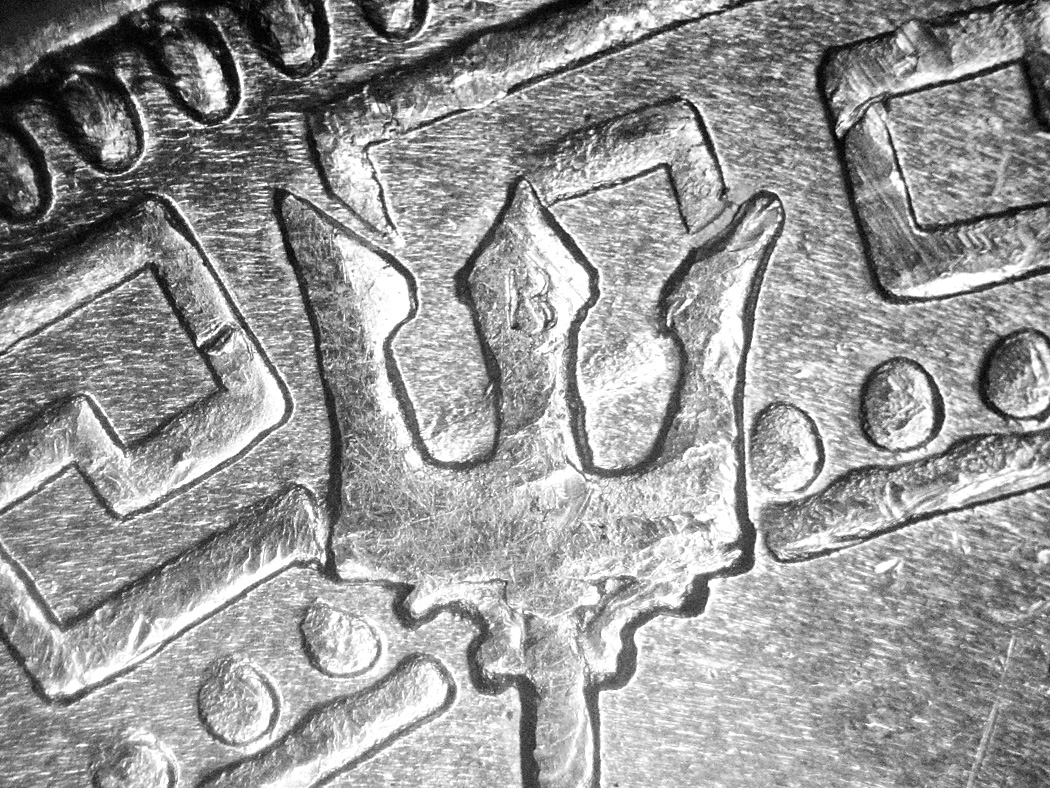
1898-B
1902-C - LDS dies. Note the shape of the denticles and the distorted corners of the design at the left and right edges of the picture
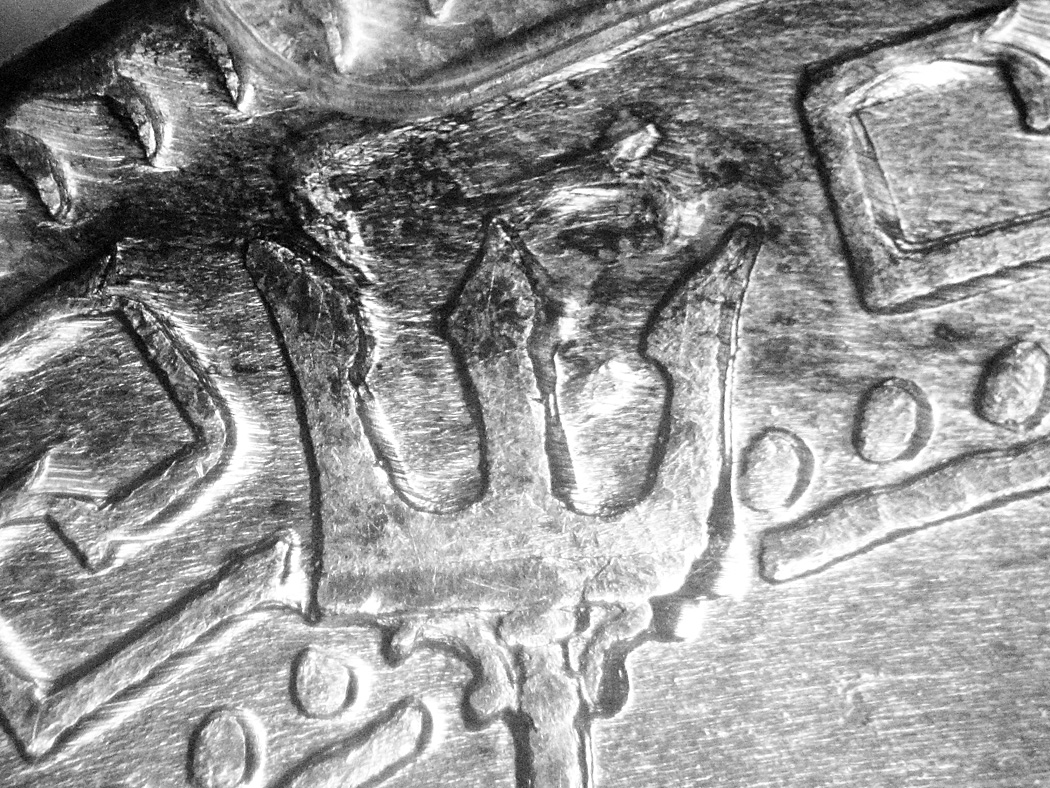
1907-B - The dies are EDS here. Note denticles are not distorted. Die polishing marks are vertical
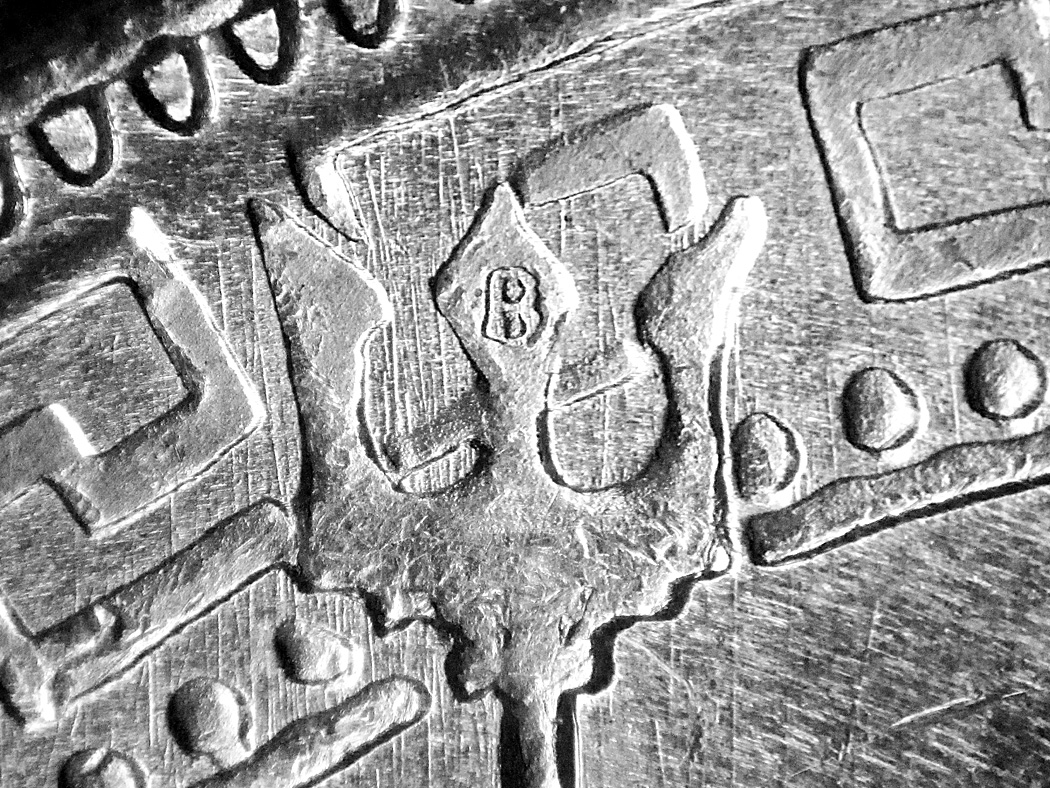
1908-B
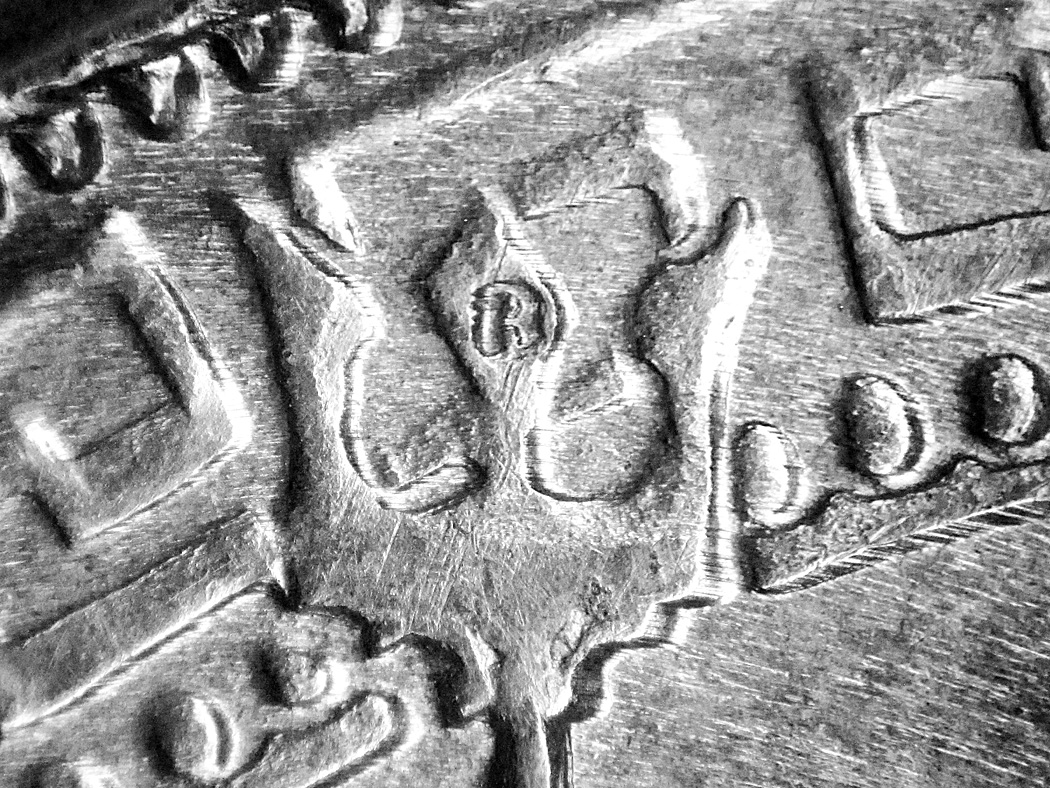
1909-B
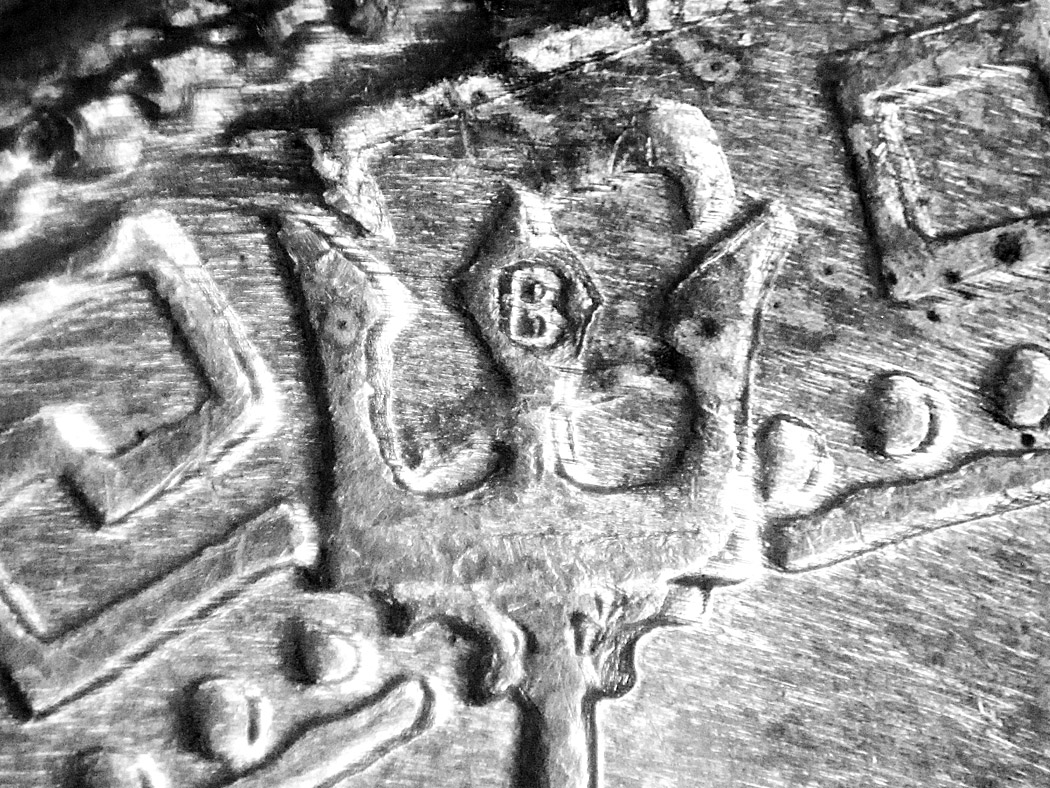
1934-B
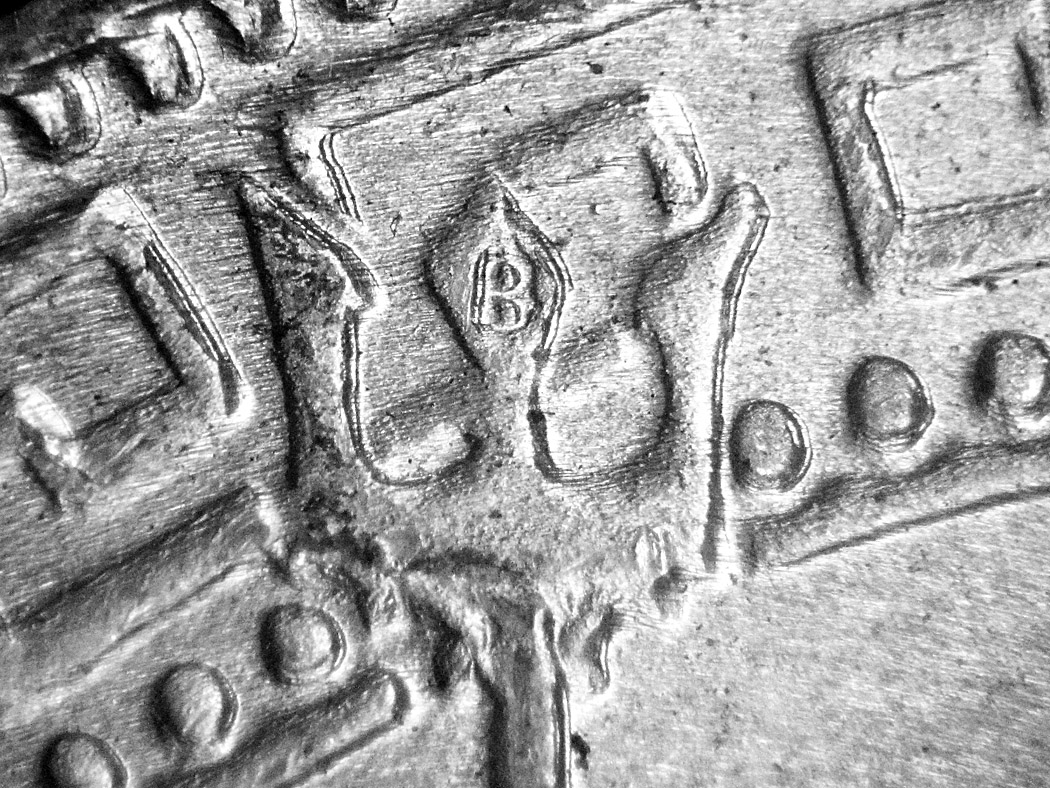
Reverses
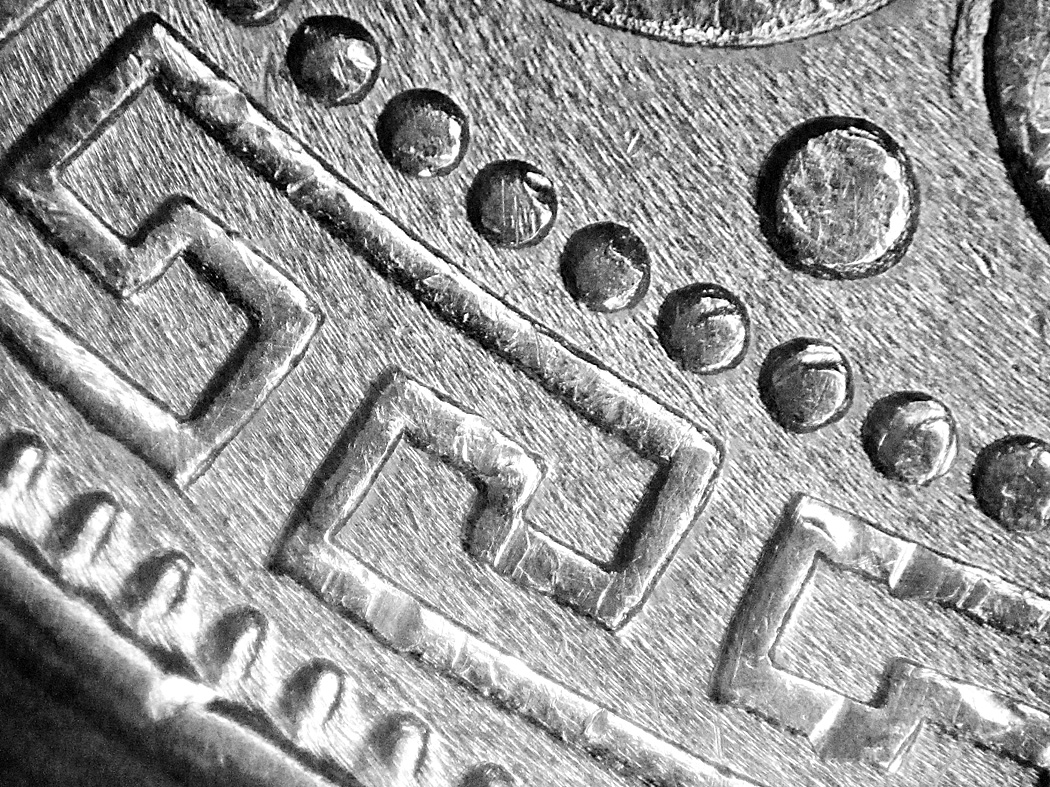
1898-B
1902-C - LDS dies. Note the shape of the denticles
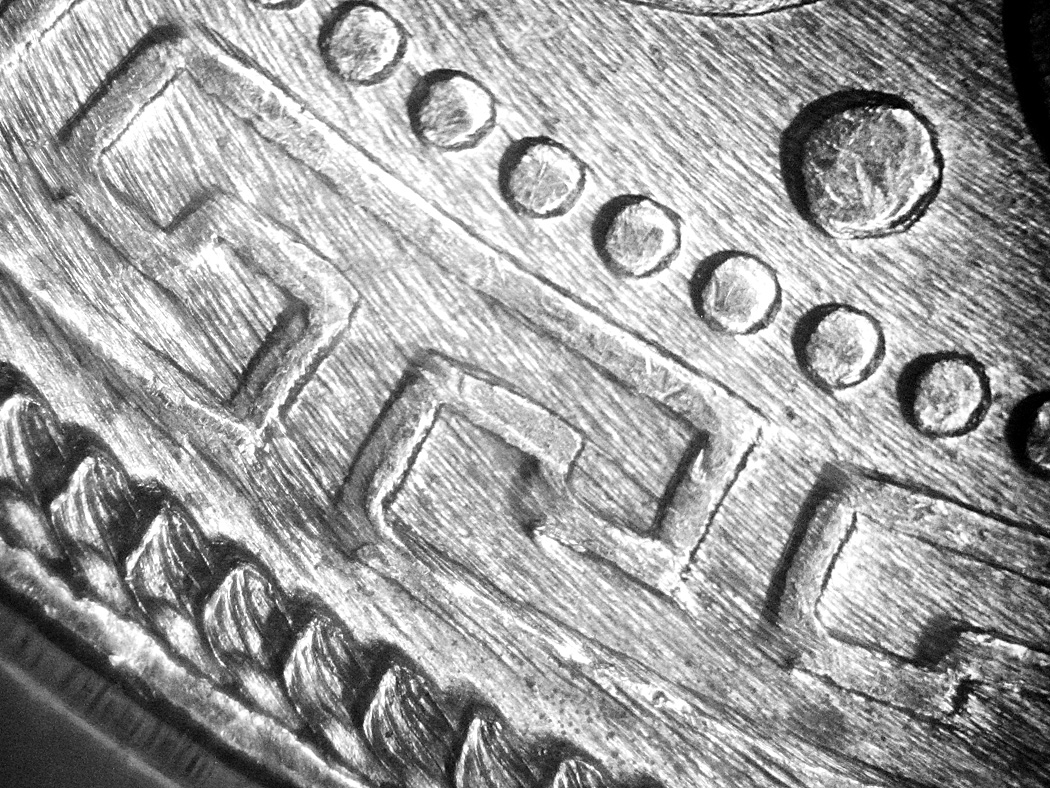
1907-B
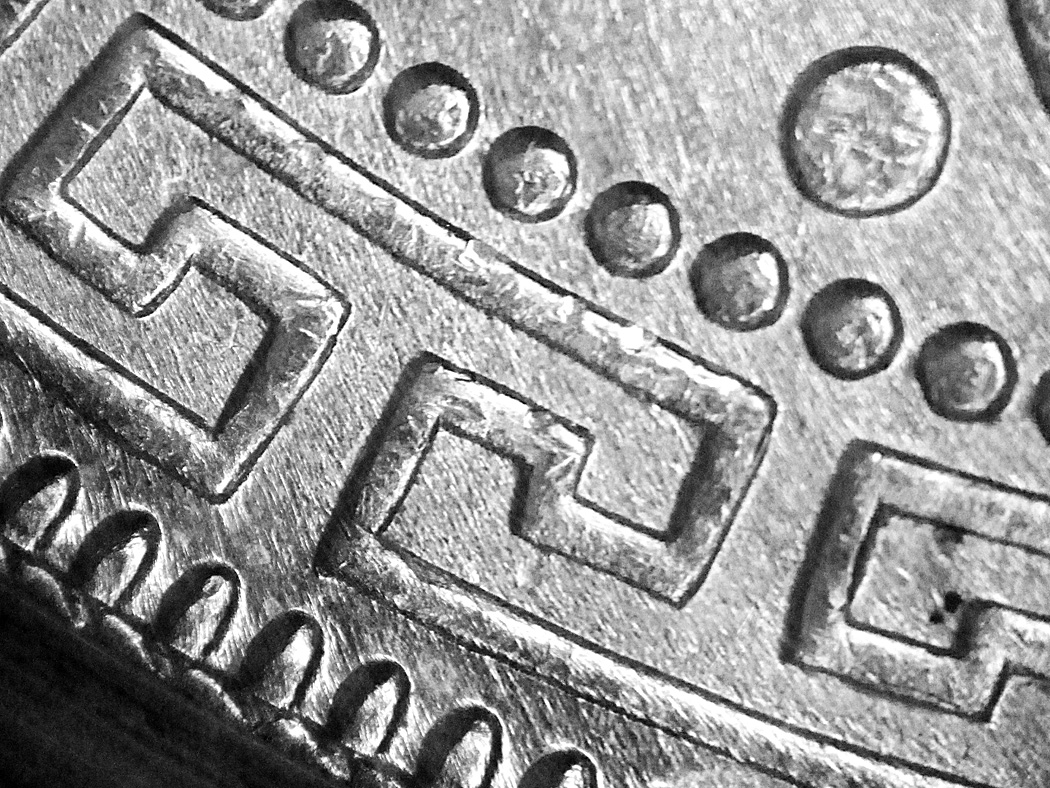
1908-B
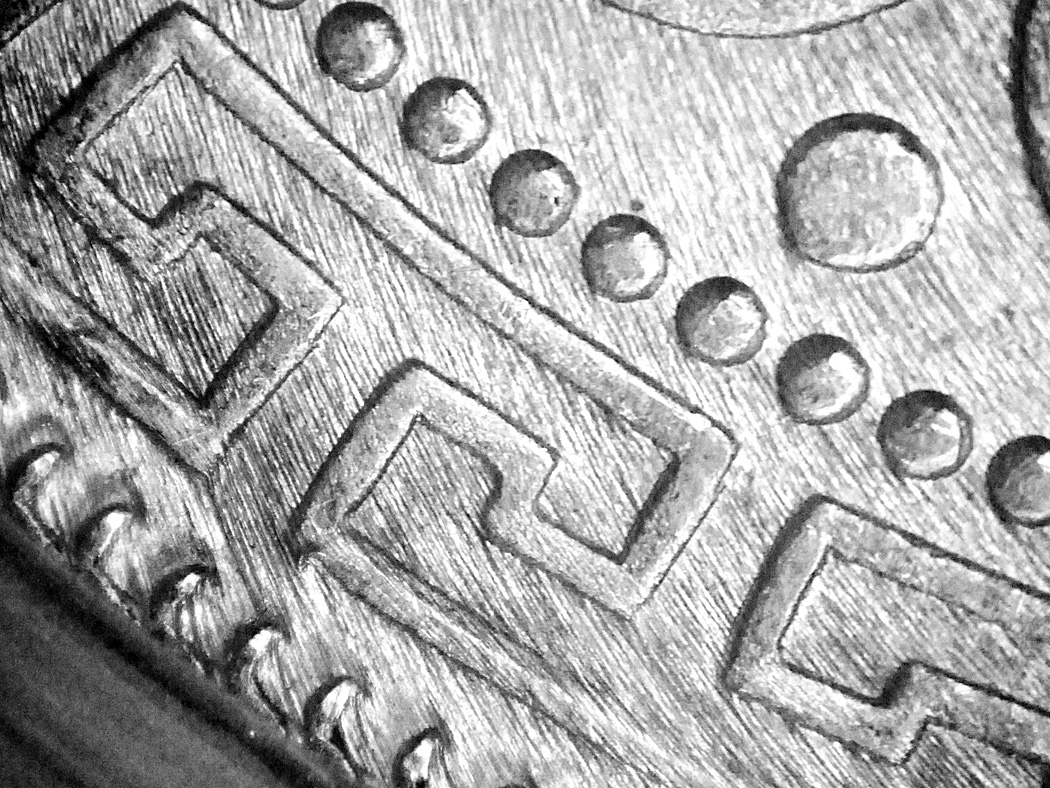
1909-B
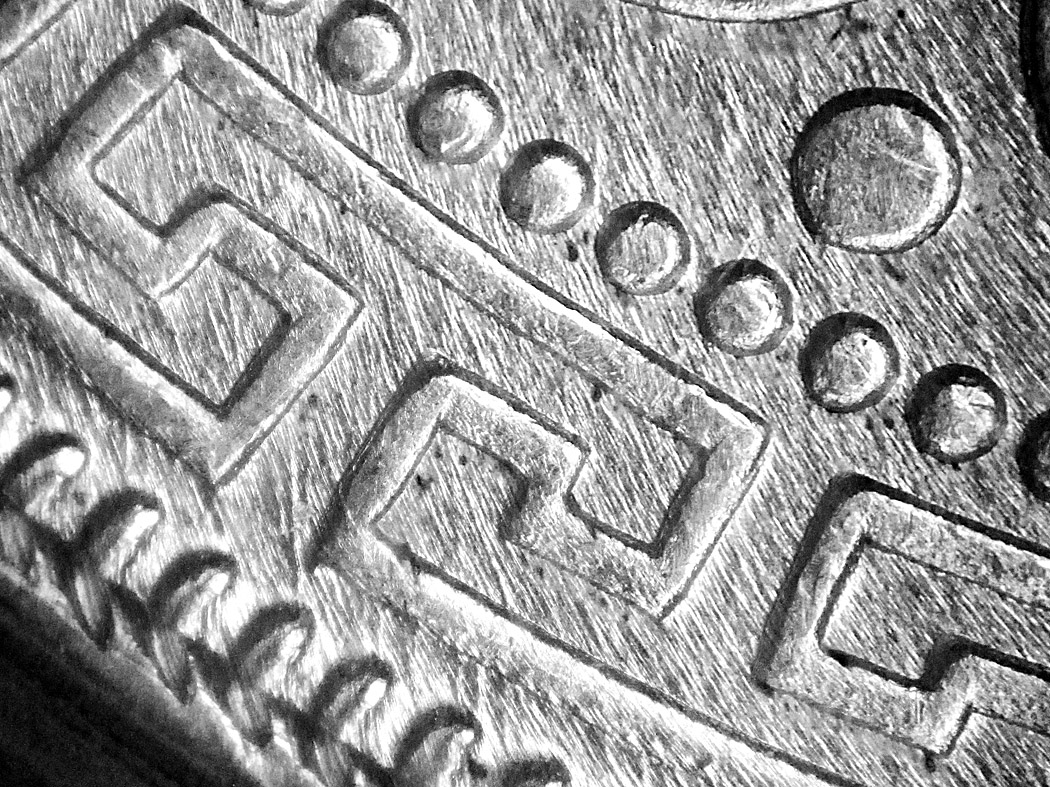
1934-B
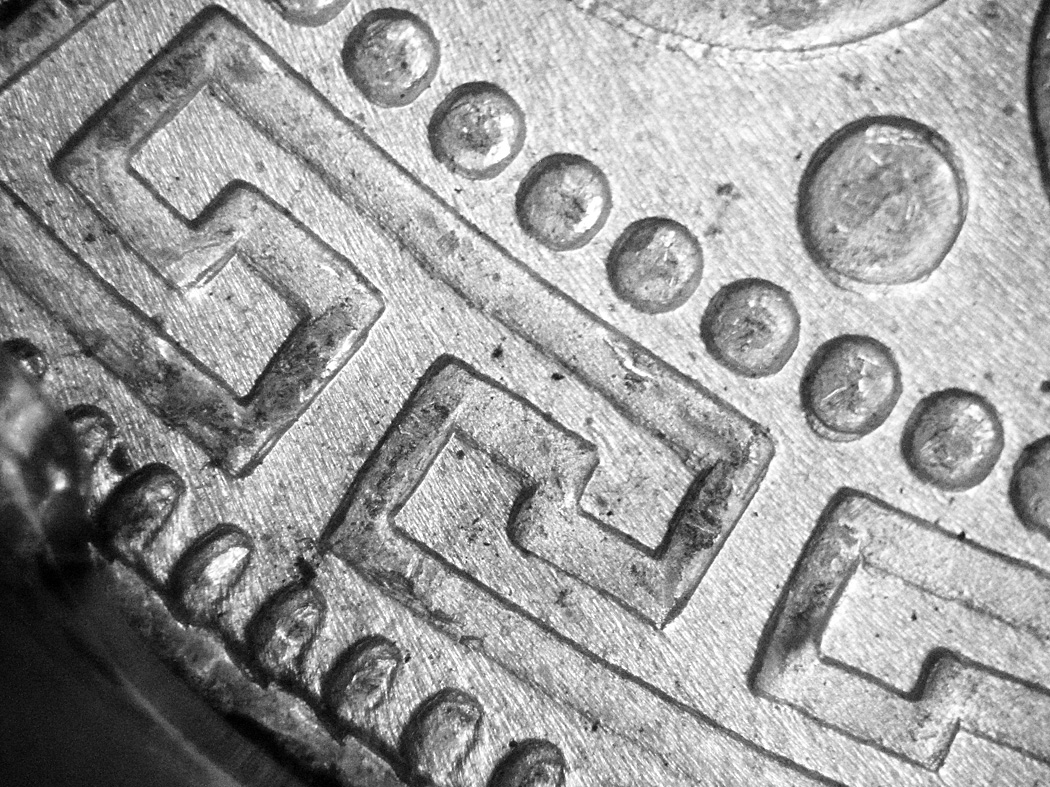
Bonus
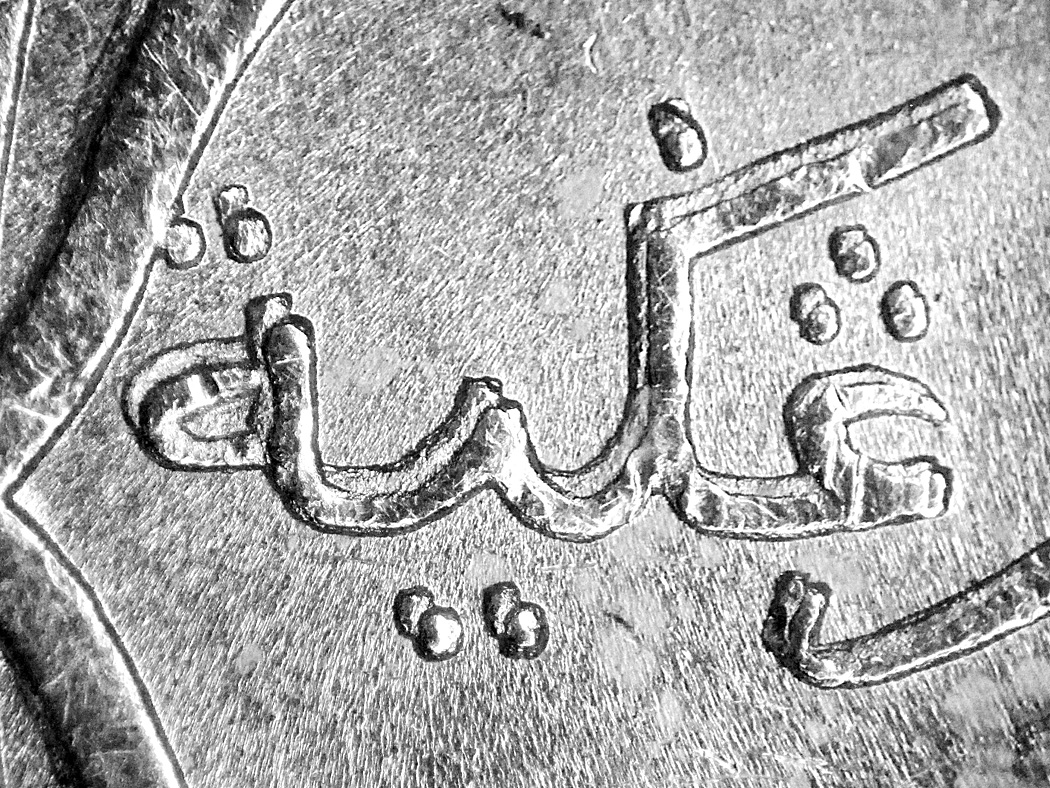
Strong doubled die reverse on the 98-B
Keeper of the VAM Catalog • Professional Coin Imaging • Prime Number Set • World Coins in Early America • British Trade Dollars • Variety Attribution
Thanks! Wonderful coin! This image shows the difference between Bombay Mint die polish (thin vertical lines) and curved metal flow from the screw press. Now, I'm 100% convinced what I was taught and passed down in my original answer is 100% correct (a few of you made me doubt myself ): The curved lines are from a very worn die used in a screw press to strike the coin. As I posted above, the same type of characteristics from die deterioration occurs on many types of coins from several countries to varying degrees.
Those who still disagree need to answer these questions:
The thing that got me believing it was flow lines was the fact that they were oriented the same across many years and two mints.
Keeper of the VAM Catalog • Professional Coin Imaging • Prime Number Set • World Coins in Early America • British Trade Dollars • Variety Attribution
The steep pitch of a screw press transforms a small radial movement into a large axial force. The vertical force of a screw press will always be higher than the torsional force, in the case of a screw imparting this force directly to a die without having an interface to negate the torsional force.
You make a sound theory. I disagree. As I alluded to, the appearance of this die erosion changes. Just as radial die erosion progresses on our coins - from virtually invisible to very noticeable - the same is true on these coins and other coins from British India and other English controlled regions of the world. See Straits Settlements for example. Furthermore, as you stated, not all coins struck using screw presses over the decades they were in use, look like the EXTREME EXAMPLE I posted in the OP.
Apples and oranges. If the die were polished to that extent (rough grinding as Tom suggests) the design would be shallow. It has nothing to do with the action of the press as the coin is being struck. That is a different thing causing the erosion to curve.
In my research, I read that a part of the screw press assembly was made into a square shape to help eliminate excessive rotation - the action of which would tend to erode the dies in the fashion shown..
@Insider2
Yep, misunderstood your question. I was making a point that the screw in a screw press has a very steep pitch that is not like a common metal screw - thus the strong vertical force allows the coin design to struck up, although less effectively towards the edge where the torsional force is stronger - this is in the case where the torsional force is not controlled. In the US Mint, the sockets enable a 100% vertical force, so there are no curved flow lines.
I almost hate to post a comment at this late stage of the game. But I think it irrelevant that the lines were the result of the type of press. If the dies rotated in the press then the devices would be similarly effected. The lines are imparted from the die itself, and were likely imparted to the die(s) by a rotary buffing tool as was pointed out by @ifthevamzarockin .
OINK
Show some pictures of the centers of some of these affected dies. We all know that flow lines tend to be minimal or non-existent near the centers of coins. A deburring brush could affect the entire surface of a die.
Thanks for finally joining the discussion! I'll bet its "new" title is not very interesting to many. Think this out some more...this is NOT a game of "likely" There is a cause and somewhere in the literature (screw presses were used at Bombay) someone must have published what was told to me by our (now dead) consultants. There was a big "Battle" about British Trade dollars in the 1970's when one "Cracked-eye" old fool who thought he was God's gift to coin authentication called a bunch of British Trade dollars cast C/F's. This caused their prices to drop in the marketplace similar to the time he called a bunch of Pillar dollars fakes. Because of him, on two different occasions dealing with each type of coin, the authenticators in DC (I was one) did an intensive study on P$ and BTD with numismatist consultants in the US and abroad to "fix" the damage he caused and to re-evaluate the genuine coins he had condemned. This research is where the information I posted that described the reasons BTD coins look this way came from. We are looking at the curved radials that give these coins their "special" luster.
There is a cause and somewhere in the literature (screw presses were used at Bombay) someone must have published what was told to me by our (now dead) consultants. There was a big "Battle" about British Trade dollars in the 1970's when one "Cracked-eye" old fool who thought he was God's gift to coin authentication called a bunch of British Trade dollars cast C/F's. This caused their prices to drop in the marketplace similar to the time he called a bunch of Pillar dollars fakes. Because of him, on two different occasions dealing with each type of coin, the authenticators in DC (I was one) did an intensive study on P$ and BTD with numismatist consultants in the US and abroad to "fix" the damage he caused and to re-evaluate the genuine coins he had condemned. This research is where the information I posted that described the reasons BTD coins look this way came from. We are looking at the curved radials that give these coins their "special" luster.
Why aren't the devices affected on Capped Bust half dollars (struck with a screw press) that show extremely large worn die radials (straight from the edge inward) caused by the continual erosion of the die? Also, more importantly, everyone is forgetting that the image is an EXTREME case. On many coins struck with screw presses, there is ONLY a hint of this type of line on the edge. AND, rather than the usual radial direction found on coins struck with "modern" presses, these tiny lines are in a DIAGONAL direction as on this BTD
Tom, that is the case. The image I posted is way past that.
Here's the center of the reverse of the 1902-C, which had the most dramatic lines in the pictures I posted above. No lines dead center, then they start forming pretty quickly as you move outward.
Keeper of the VAM Catalog • Professional Coin Imaging • Prime Number Set • World Coins in Early America • British Trade Dollars • Variety Attribution
@messydesk
One sign of an educated scholar is the ability to change one's belief/opinion when confronted with new evidence. You are the scholarly "carpenter" that drove the nail into this discussion. Thank you for the images. Unfortunately, I don't think we'll change many opinions.
are the scholarly "carpenter" that drove the nail into this discussion. Thank you for the images. Unfortunately, I don't think we'll change many opinions. 
This week I shall look for some of the very tiny diagonal die erosion found on other coins struck by a screw press with fresher dies.
"No lines dead center, then they start forming pretty quickly as you move outward."
Agree, and they seem to have a bit of a spiral direction as they move out.
This would seem to be consistent with the idea of a screw press and die flow.
The lines to the right (in red) would seem to be longer and going in a slightly different direction.
This would seem slightly inconsistent with the flow.
This photo would seem to show arching lines that a few slightly change directions.
I would think they should be more of a spiral from the center of the coin.
This is just a dumb guess on my part.
These photos seem to show slightly different directions to the lines.
I would think the flow would be more consistent unless the amount of rotation is changing.
Again this is just a dumb guess on my part.
Thanks @messydesk for providing the images to prove the lines were imparted by the action of a screw press, and not die polishing.
I spent a couple of hours looking through Tompkins, Dannreuther, and Heritage archives for US Mint 1794-1830's high grade LDS coins, found nothing but radial flow lines. There could be exceptions for rotated dies. The setup at US Mint for screw presses used sockets to eliminate torsional, or twisting force on the dies. Some numismatists have referred to them as die cups, but the US Mint called them sockets. Other mints such as Bombay, evidently did not attempt to control torsional movement, and as mentioned earlier possibly secured the die directly to the screw - with a steep pitch this was possible.
@Nysoto:
The image of the center, and the by @messydesk prove this, as the dentils and peripheral devices are the most deformed.
At first glance in the OP photo the lines could appear to be from a wire brush as brushed AL or mild steel appears. I would doubt that dies could quickly be brushed to that appearance as hardened steel dies are harder than wire brass or steel brush. It could be done quickly with a coarse compound on a polishing wheel, but that action results in random direction of lines from being hand-held during deburring, and not the symmetrical curved lines pictured in this thread.
This has been an interesting thread - @Insider2 needs to write a research article!
The image you posted somehow disappeared. To help avoid any confusion I thought it might be helpful to put it back.
Thanks for the image.
@Nysoto said: "This has been an interesting thread - @Insider2 needs to write a research article"
As I stated several times, I thought this was common knowledge settled decades ago by numismatists much older and knowledgeable than a twenty-something rookie authenticator. I think the word will get out to the younger collectors because of this discussion. Several here including yourself have provided the proof and kept up the interest by well thought out disagreement and opinion. It sure caused me to think about this characteristic on the coins more deeply.
I disappeared when I altered the discussion title when you disagreed. Thanks for reposting it.